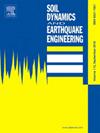The role of underground archaeological remains on the seismic response of a historic tower
IF 4.2
2区 工程技术
Q1 ENGINEERING, GEOLOGICAL
引用次数: 0
Abstract
The Italian territory features plenty of historic masonry buildings, many of which have undergone reconstruction, often atop ancient ruins. The presence of archaeological remains in the shallow layers of the ground is always disregarded in the seismic assessment of masonry buildings. To address this gap, the paper delves into the influence of underground masonry ruins on the seismic response of a bell tower built above a historic soil deposit. A comprehensive 3D finite-element model encompassing the tower, foundation, soil, and underground remains was developed. A parametric analysis was conducted, involving modifications to the geometry, mechanical properties, and location of the buried ruins. From the parametric study it emerged that the buried walls could alter the seismic signal at the base of the structure. The most critical scenario occurs when the buried archaeological ruins have a grid spacing comparable to the characteristic size of the foundation, especially in soft soils. Analysis of displacements, accelerations, and spectral accelerations at different elevations along the tower height revealed that the presence of archaeological ruins could modify the seismic response of the structure built above them.
地下考古遗迹对历史古塔地震响应的影响
意大利境内有许多历史悠久的砌体建筑,其中许多都经过了重建,而且往往是在古代遗迹的基础上重建的。在对砌体建筑进行抗震评估时,人们总是忽略浅地层中存在的考古遗迹。为了弥补这一不足,本文深入研究了地下砌体遗址对建在历史性土壤沉积之上的钟楼地震响应的影响。本文开发了一个包含钟楼、地基、土壤和地下遗迹的综合三维有限元模型。进行了参数分析,包括修改几何形状、机械性能和地下遗迹的位置。参数研究表明,掩埋的墙壁会改变结构底部的地震信号。当埋入地下的考古遗址的网格间距与地基的特征尺寸相当时,尤其是在软土中,情况最为严重。对塔楼高度不同标高处的位移、加速度和频谱加速度的分析表明,考古遗址的存在会改变其上建筑结构的地震响应。
本文章由计算机程序翻译,如有差异,请以英文原文为准。
求助全文
约1分钟内获得全文
求助全文
来源期刊

Soil Dynamics and Earthquake Engineering
工程技术-地球科学综合
CiteScore
7.50
自引率
15.00%
发文量
446
审稿时长
8 months
期刊介绍:
The journal aims to encourage and enhance the role of mechanics and other disciplines as they relate to earthquake engineering by providing opportunities for the publication of the work of applied mathematicians, engineers and other applied scientists involved in solving problems closely related to the field of earthquake engineering and geotechnical earthquake engineering.
Emphasis is placed on new concepts and techniques, but case histories will also be published if they enhance the presentation and understanding of new technical concepts.
 求助内容:
求助内容: 应助结果提醒方式:
应助结果提醒方式:


